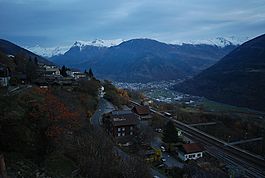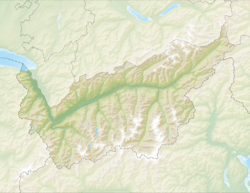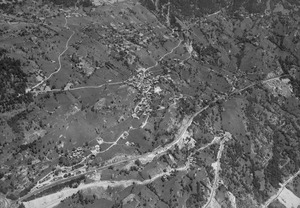Ausserberg facts for kids
Quick facts for kids
Ausserberg
|
||
|---|---|---|

Ausserberg village
|
||
|
||
| Country | Switzerland | |
| Canton | Valais | |
| District | Raron | |
| Area | ||
| • Total | 15.01 km2 (5.80 sq mi) | |
| Elevation | 1,008 m (3,307 ft) | |
| Population
(Dec 2020 )
|
||
| • Total | 621 | |
| • Density | 41.37/km2 (107.15/sq mi) | |
| Postal code |
3938
|
|
| Surrounded by | Baltschieder, Eggerberg, Raron | |
Ausserberg is a small town, also called a municipality, in the Raron area of Valais, a canton in Switzerland. It's a lovely place with a rich history and beautiful natural surroundings.
Contents
History of Ausserberg
Ausserberg was first mentioned in official papers way back in 1378. Back then, it was known by a different name, Leucrun. Later, in 1401, it was called mons episcopi, and by 1523, it was known as mons exterior. These old names show how the town's identity changed over many years.
Exploring Ausserberg's Geography
Ausserberg covers an area of about 14.9 square kilometers (about 5.75 square miles). A big part of this land, about 23.8%, is used for farming. Forests cover almost half of the area, at 45.2%. Only a small part, 2.3%, has buildings or roads. The rest, about 28.7%, is natural, undeveloped land.
The town is located on the northern side of the Rhone valley. It sits between two natural features: the Baltschiederbach stream and the Bietschhorn mountain. Ausserberg isn't just one big town. It's made up of several smaller villages spread out. The main village, Trogdorf, is about 1,008 meters (3,307 feet) above sea level.
There was a plan to combine Ausserberg with some nearby towns like Eggerberg and Visp. However, the people living in these towns decided not to go ahead with the merger.
Ausserberg's Coat of Arms
The coat of arms for Ausserberg has a special design. It shows a golden cross and a black double-headed eagle. These symbols are placed on a green hill with five peaks. A silver five-pointed star is also part of the design, surrounded by four smaller stars. This design tells a story about the town's past and its values.
Who Lives in Ausserberg? (Demographics)
Ausserberg has a population of about 661 people. A small number of people, about 5.7%, are foreign nationals living in the town. Over the last ten years, the number of people living here has changed only a little. It grew a bit because more people moved in than moved out.
Most people in Ausserberg, about 98.6%, speak German as their main language. A few people also speak Serbo-Croatian or French.
In 2008, the population was almost evenly split between males and females. About 48.6% were male and 51.4% were female. Most of the people living in Ausserberg were born there or in the same canton.
When looking at age groups, young people (under 19 years old) make up about 24% of the population. Adults (20-64 years old) are the largest group, at 55.6%. Seniors (over 64 years old) make up 20.4%.
There are about 254 households in Ausserberg, with an average of 2.4 people living in each. Many homes are lived in all year round.
The chart below shows how the population of Ausserberg has changed over time:

Ausserberg's Economy
In 2010, Ausserberg had a very low unemployment rate, at just 0.7%. This means almost everyone who wanted a job had one.
The town's economy is divided into three main parts:
- Primary sector: This includes jobs related to nature, like farming. In 2008, about 85 people worked in this area, mostly in agriculture.
- Secondary sector: This involves making things, like in factories or construction. Only 10 people worked in this sector, mainly in building.
- Tertiary sector: This is about services, like shops, hotels, or schools. About 49 people worked in this sector. Many of these jobs were in hotels or restaurants.
Most people who live in Ausserberg work outside the town. About 26.5% of workers use public transport to get to their jobs, while 54.5% drive their own cars.
Getting Around: Transport in Ausserberg
Ausserberg has its own Ausserberg railway station on the Lötschberg line. This station is about 900 meters (about half a mile) from the main village of Trogdorf. You can catch trains from here to cities like Bern, Thun, and Brig.
There's also a PostAuto bus service. This bus connects the Ausserberg train station to Trogdorf village, and then goes on to nearby towns like Baltschieder and Visp.
Religion in Ausserberg
Based on a 2000 survey, most people in Ausserberg, about 93.2%, are Roman Catholic. A smaller group, about 2.7%, belong to the Swiss Reformed Church. There are also a few people who are Orthodox or Buddhist. About 1.91% of the population said they didn't belong to any church or preferred not to say.
Learning and Education in Ausserberg
Many adults in Ausserberg have completed a good level of education. About 37.1% have finished non-mandatory high school, and 4.8% have gone on to higher education, like a university.
During the 2010-2011 school year, there were 48 students in Ausserberg's school system.
- Kindergarten: Young children can attend one year of non-obligatory Kindergarten. In that year, there were 9 kindergarten students.
- Primary School: Students must attend six years of primary school. Ausserberg had 4 classes and 48 students in primary school.
- Secondary School: For older students, the secondary school program has three required years, followed by optional advanced schools. All secondary students from Ausserberg go to schools in nearby towns.
Ausserberg also has a local library called the Gemeinde- und Schulbibliothek. In 2008, it had 1,700 books and other items. It loaned out 2,100 items that year. The library was open 112 days a year, for about 2 hours per week.
See also
 In Spanish: Ausserberg para niños
In Spanish: Ausserberg para niños





